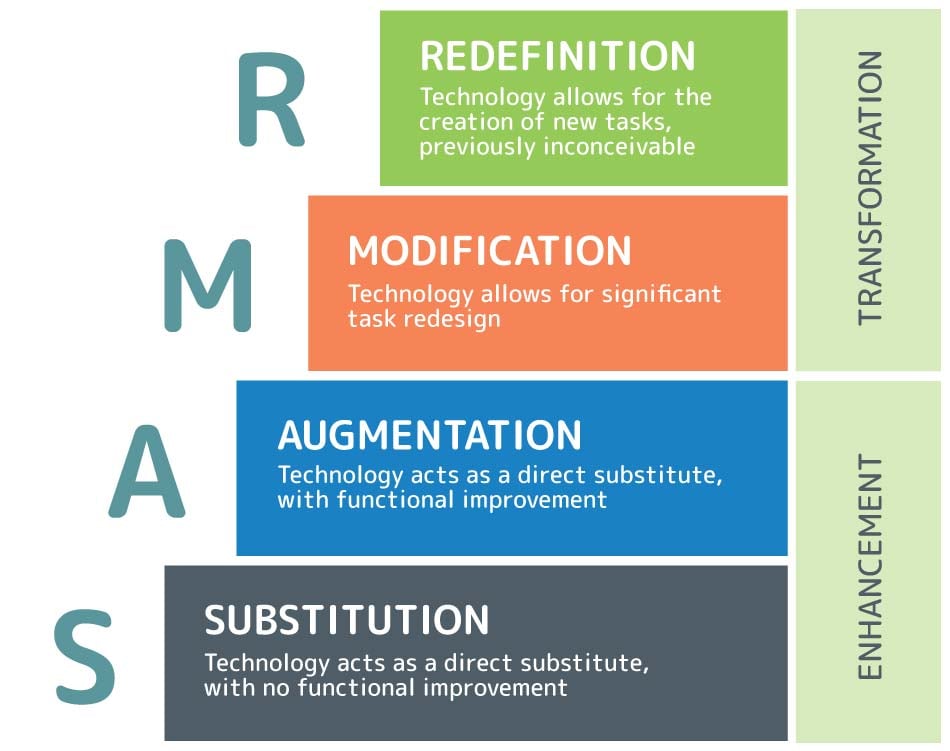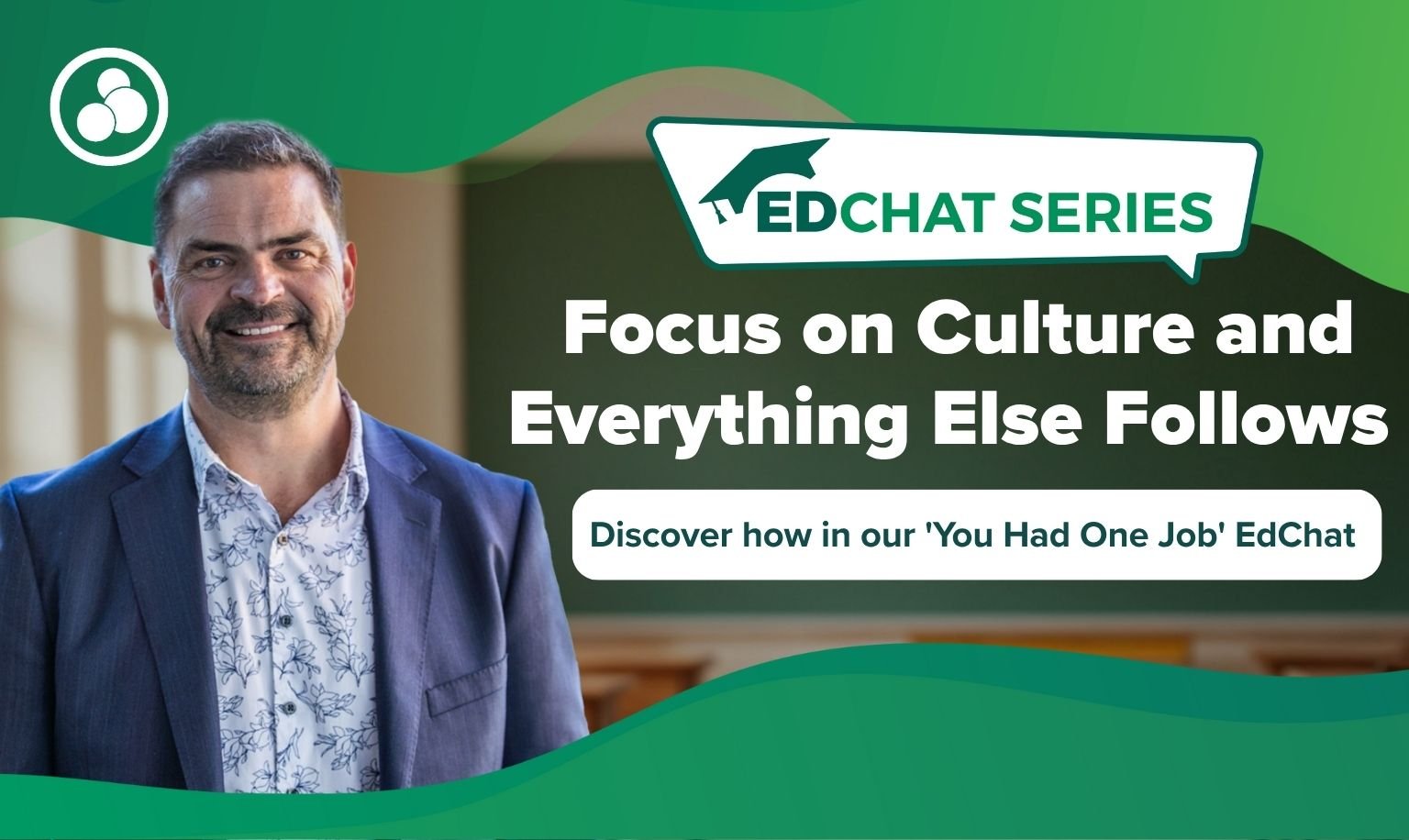
What is the SAMR model?
The SAMR model is a framework that orders strategies for classroom technology implementation into four stages:

In each stage of the SAMR model, the use of educational technology (EdTech) becomes increasingly sophisticated.
Substitution and augmentation strategies use EdTech to enhance learning and add value, whereas modification and redefinition stages harness EdTech to transform learning and make new things possible.
The effectiveness of any of these four strategies depends on when and how it is used.
Here’s how you can harness each stage for more powerful classroom learning:
Substitution
This is the simplest stage, where EdTech is used as a direct substitute for traditional practices.
Substitution strategies can save you time and space by cutting back on laborious pen and paper tasks. Instead of printing out twenty-plus paper resources that clog the cupboard, you can use technology to manage resources with just a few clicks.
Substitution also provides a much more accessible introduction to technological soft skills than modification and redefinition. It’s the perfect opportunity for students to get comfortable with new technology before you start to transform their learning.
Examples of substitution
- having students type their work instead of handwriting it
- using online quizzes and programs instead of pen and paper
- uploading a worksheet in PDF for student access, as opposed to photocopying
- using a digital interactive whiteboard as opposed to a traditional whiteboard and saving the results as a document.
Remember: Substitution strategies do not change the learning process or outcome. Ask yourself what you and your students will gain from the technology before implementing it. If it adds nothing but hassle, stick to pen and paper.
Augmentation
At the augmentation stage, technology adds something to the learning process beyond just convenience. It might give your students a clearer understanding of a complex topic or making it engaging in a way that traditional methods can’t.
It also allows for the introduction of more independent and student-centric learning. By using technology as a source of information, students can start actively learning without requiring constant teacher-led instruction.
Examples of augmentation
- Students give more informative and engaging oral presentations accompanied by a PowerPoint or Prezi containing multimedia elements.
- Students use the internet to independently research a topic, as opposed to relying on teacher input.
- Students use an EdTech program that gamifies curriculum content for student engagement and allows students to track progress in an accessible way.
- Teacher instruction is supplemented with a video that clarifies a particularly hard to explain concept.
Modification
At the modification stage, technology is used to design interactive and dynamic tasks that go beyond the limitations of a traditional classroom.
For example, students can collaborate on shared documents, or work in large groups, allowing for seamless collaboration and knowledge sharing. This peer-to-peer work nurtures a more cooperative and dynamic class culture.
Technologically modified tasks also allow students to generate inspired and innovative work that isn’t confined to paper. Some students will jump at the opportunity to get in front of a camera, while others will do anything to make it onto the global Mathletics leaderboard.
Examples of modification
- Students produce podcasts summarising a topic, which can then be accessed by other students as a revision resource.
- Students create an informative video presentation in place of a standard oral presentation. They can use their voice alongside a broader variety of creative multimodal components.
- Students use a technological tool that makes an abstract concept visible in a hands-on, responsive way (e.g. voyaging on Google Earth to better understand measurement and geography).
Redefinition
The most sophisticated stage of SAMR, redefinition sees you using technology to make entirely new learning opportunities possible.
Redefining learning has the potential to connect learning with the real world and produce authentic outcomes. It also gives students strong technological soft skills such as digital collaboration, communication, technological literacy, and the ability to adapt to new systems and processes.
Most importantly, using technology to redefine learning in your classroom translates to vibrant and engaged students who embrace a growth mindset.
Examples of redefinition
- connecting your students with other people around the world as part of the learning journey
- having students publish their work online where it can be viewed by peers and the broader community
- recording students as they deliver a presentation or practice a physical skill, then using this recording to prompt student reflection
- experimenting with tasks that use extensive multimodal elements (e.g. producing documentaries or short films, webpages, print documents with creative layouts).
Remember, redefinition isn’t the same as ‘high tech’. A learning experience is redefined when it integrates technology seamlessly and meaningfully to open new doors for student learning – regardless of how sophisticated that technology might be.
In an English classroom, this might involve learning how to critically assess online media during web-based research. In mathematics, students might look at data represented through amazing visuals and get inspired to create their own.
Find your purpose
Starting with a purpose avoids the ‘technology for technology’s sake’ that sometimes infiltrates the classroom.
Ask yourself:
- What am I hoping to achieve by using this technology?
- How will it make a difference to my students’ learning?
- Why is it preferable to not using technology?
- How equipped are my students and I to use this technology?
- How much time do I have to invest in making it work?
These simple questions can make it simpler to determine which stage of the SAMR model suits your needs. Remember that you don’t always have to redefine your students’ learning. A few simple technological additions to an already effective teaching strategy might be all you need to make a difference.
Using technology in the classroom sends a clear message to students. It shows them that you’re connecting learning to the rapidly changing world outside the classroom walls, and you aren’t afraid to adapt to a new challenge. Get creative with technology and you’ll inspire as well as teach.






